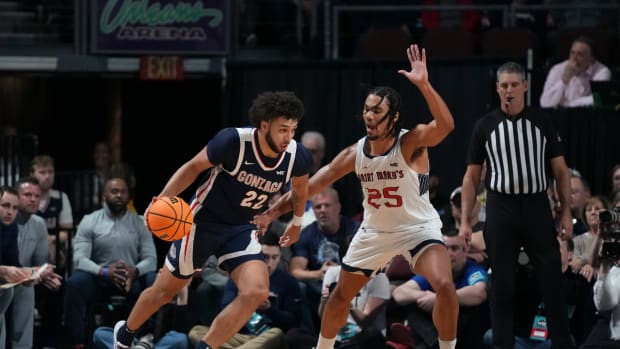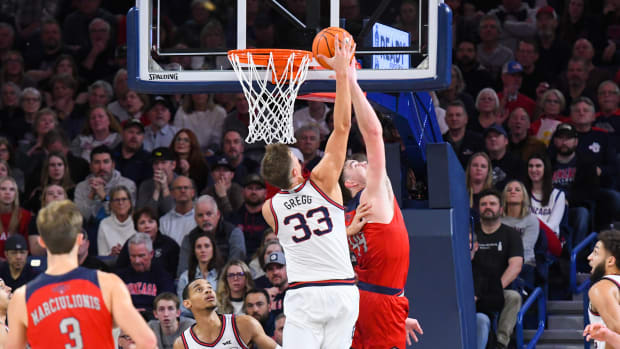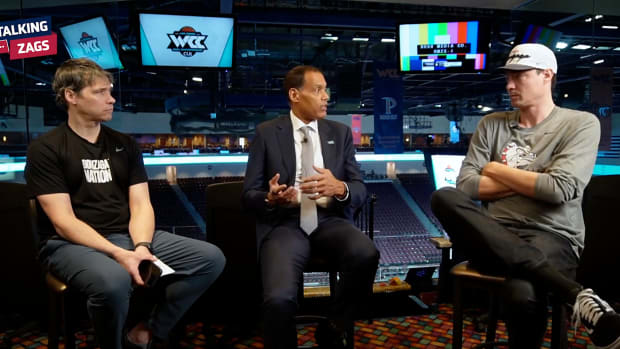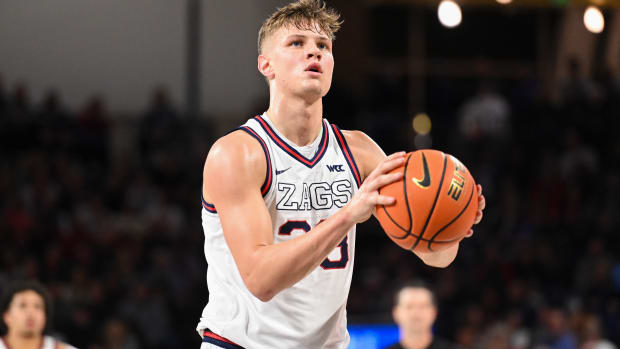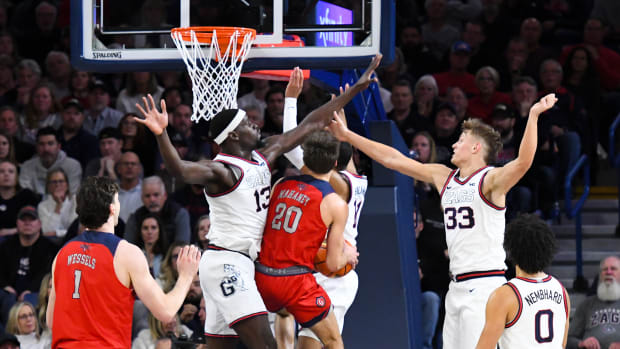WCC roundup: Teams finish nonconference play
If one thing has become evident after the West Coast Conference teams have now all finished their nonconference schedules, it’s that the caliber of play this year is going to go up for the programs looking to contend for the WCC title. COVID-19 related protocols have a number of teams sitting out the first week of conference action, but each program has still played at least 13 games outside the conference up to this point. With the first half of the regular season complete, find out how each team is looking before the WCC title run begins.
San Francisco Dons (13-1):
Everyone would be hard pressed to find someone who thought San Francisco would be the last undefeated team in the WCC conference, be the fastest team in the nation to win seven games or sit atop the WCC after nonconference play is over. None of those predictions matter now however, as the Dons have accomplished all of those feats and now own the best record out of all WCC schools at 12-1. A lineup with a strong veteran presence seems to be itching for a spot in the NCAA tournament come March, and with quality wins against Nevada, Arizona State and Towson, a post season run does not feel out of hand.
While graduate guard Jamaree Bouyea is so far having a paramount season shooting and distributing the ball for the Dons, it’s on the defensive end where the team collectively shines. They currently have the 17th best defensive efficiency rating in the nation according to KenPom, with impressive defensive stands against higher level offenses like UNLV, UAB and Fresno State. Even in the Dons’ sole defeat against Grand Canyon, they only allowed the Antelopes to put up 49 points in a one-point loss. The Dons should expect to play against high level defensive squads like Gonzaga and BYU once WCC action gets underway.
Gonzaga Bulldogs (11-2):
Mark Few makes sure his teams run a gauntlet every year in nonconference play to prime them for WCC action. Now sitting at 10-2, the No. 4 Bulldogs’ strengths and weaknesses have been displayed in front of the whole nation and the rest of the WCC. Quality wins against No. 17 Texas and No. 6 UCLA had the public believing Gonzaga was even more unblemished than last year. After a loss to No. 2 Duke in Vegas and then No. 19 Alabama in Seattle though, the Zags looked anything but impervious. They had clear troubles shooting the ball outside and making the cutting passes in the half court, meanwhile opposing teams were finding more success creating space with the ball.
After the Alabama loss, the Zags picked up their offensive efficiency, converting 37.3% of their 3-point attempts and 49.7% of their field goals in their following three wins against Merrimack, No. 25 Texas Tech and NAU. GU’s three-point shooting dipped again in the team’s final nonconference win against Northern Alabama, so the Zags will look to find greater consistency on the court once the team makes it out of health and safety protocols.
BYU Cougars (12-3):
This year especially, it seems like the 11-3 BYU Cougars have framed their team makeup to mirror Gonzaga’s play style to a tee. A strongly mixed guard-forward lineup that moves up and down the court with efficiency has been giving many of its opponents hardships just trying to keep up with the score. Starting off the year strong with wins against San Diego State, Oregon and Utah, the Cougars are at their peak when they’re afforded multiple open looks at the hoop. That comes from the team’s ability to clean up the offensive glass and then pass shooters open. The No. 32 team in the nation in adjusted offensive efficiency according to KenPom, BYU have afforded themselves multiple shot opportunities in the same possession in part thanks to their 180 offensive rebounds through 15 games.
After taking losses against Utah Valley, Vanderbilt and Creighton because all those teams were to minimize BYU’s time of possession, a gritty 54-39 win against Southern Florida proved that BYU can slow the game down and still grind out wins. The Cougars start up their WCC run with an away game against Pacific on Jan. 6.
Saint Mary’s Gaels (11-3):
At 11-3, the Saint Mary’s Gaels have once again proved themselves to be a top contender for the WCC title heading into conference play. A team rooted in defense has held opponents to less than 60 points in nine of its first 14 games so far, while they themselves have averaged 67.5 points per game on the back of senior forward Matthias Tass.
The Gaels were tested early on this season at the Maui Jim Maui Invitational where they pulled off wins against Notre Dame and Oregon before falling to No. 24 Wisconsin. Going on a strong run from there with only losses at No. 20 Colorado State and against San Diego State, it’ll be a battle when the Gaels take on a hot University of San Francisco team to start WCC play on New Year’s day.
Santa Clara Broncos (10-5):
The 10-5 Santa Clara team this year has performed best when its offense has been able to flow uninterrupted. Both from the half court and out in transition, when the Broncos are comfortable on offense, opponents have had a hard time keeping up with them. While the Broncos were able to accomplish this with wins against teams like Stanford, Nevada and TCU, they had a really hard time getting their attack off the ground versus Fresno State, UC Irvine and Cal Berkeley.
Since losing back-to-back contests against Cal and Boise State, the Broncos finished off their nonconference run with three straight wins against evidently weaker opponents. Still, their offensive tempo has been building toward a season best with the Broncos putting up no less than 79 points in those games, making Santa Clara a lethal first opponent for the Saint Mary’s Gaels on Jan. 6.
Portland Pilots (9-6):
The Pilots aren’t often thought to be upper-echelon competition in the WCC and they’re still not there, but the Pilots’ stock is definitely rising after a stronger than usual nonconference performance. Entering conference play with a 9-6 record, the Pilots most recently toughed out a 65-60 come-from-behind win on the road against UC Davis.
They struggled mightily against their bigger opponents like Oregon and San Jose State, but a one-point victory against Cal Poly showed the Pilots have a fighting quality that may not have been there in seasons prior. That mettle will surely be tested when Portland eventually clears COVID-19 related protocols, which have postponed at least Portland’s conference opener set to be played against BYU on New Year’s day.
Loyola Marymount Lions (7-5):
It’s no surprise that en route to a 7-5 record to start the year, the Lions have leaned heavily on fifth year player Eli Scott. In what’s most likely his final collegiate season, Scott has put up 15.6 PPG on 50% FG shooting. He’s also been the team’s leading rebounder, which is more a result of LMU’s clear lack of size than the 6-foot-6 forward’s prowess on the glass. The team doesn’t have a player over 6-foot-8, and LMU has struggled against bigger opponents especially, like when they played Florida State in the Jacksonville Classic and lost 48-73.
More complete showings by the Lions have awarded them wins against Southern Methodist, Long Beach State and Tulsa, but they need more than just Scott to turn up against conference opponents if the Lions want to make a WCC title run. LMU opens up conference action on Jan. 6 against Portland if the Pilots can clear health and safety protocols by that point.
San Diego Toreros (7-6):
If the currently 7-6 San Diego Toreros want to get back to .500 in conference play for the first time since the 2017-18 season, the team will need to find their scoring abilities again. Through their first four games, the Toreros were averaging 80.5 PPG and were sitting at 2-2, including a 75-68 win against Nevada. Since then however, despite winning more than they’ve lost, the Toreros have only been putting up 60.3 PPG and the team now sits at the bottom third of the nation in KenPom’s adjusted offensive efficiency and tempo ratings. T
hey’ve been going back and forth against bigger opponents with losses to Fullerton, Cal State Northridge and UNLV, and wins against Cal Poly and Northern Arizona. The Toreros will need to find a way to consistently produce if they want to have a strong WCC campaign which is already off to an unsure start now that USD is in health and safety protocols which have delayed its first two WCC games.
Pepperdine Waves (6-9):
It was big when the Waves lost playmaking catalyst Colby Ross at the end of last season, but their woes this year that have led to a 6-9 record have been symptomatic of far more than just Ross’s absence. Issues on defense have allowed Pepperdine’s opponents to put up 72.6 PPG so far. Their nonconference schedule included matchups with a number of opponents that other WCC teams similarly faced, but the Waves faired sizeably worse against them.
Nonconference opponents like UCSB, Cal Poly and Nevada that were handled by other WCC schools ended up giving Pepperdine trouble on both sides of the court. With a KenPom adjusted offensive rating that ranks in the bottom third of the entire Division I, the Waves will need to amend issues on at least one side of the ball if they want have a .500 record in the WCC for the third year in a row.
Pacific Tigers (5-9):
It was evident that last season, Pacific was on a trajectory toward sustainable growth in the program. Then with the departure of head coach Damon Stoudamire for the NBA set the Tigers back to a period more reminiscent of when they were barred from postseason competition a few years back.
Mustering a 5-9 nonconference record against mostly teams from the Big West, Big Sky and Western Athletic Conference hasn’t highlighted many bright spots for the Tigers this year outside of senior forward Jeremiah Bailey. Bailey came into his own as an offensive and defensive catalyst last season, and has continued that effort at the forefront of the Tigers’ efforts on both sides of the courts.
Pacific’s efforts aren’t going to help with the pause in program operations that hit the team due to COVID-19 related protocols. The Tigers’ first two games of WCC action have been postponed as the team looks to get back on the court with a sufficient number of players.
